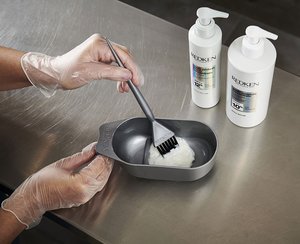Hair Bonds 101: What Are They and How To Fix Them?

Having and maintaining healthy hair is not only about its external look but also about taking care of the inner strength of the strands. At the core of strong and resilient hair are the bonds that keep it together. With time, these bonds can be damaged by several factors, including environmental stress, heat styling and chemical treatments.
The good news is that fixing these essential bonds is possible if you use the right bonding care products. In this article, we will shed light on what hair bonds are and how you can repair them to revive your dry, damaged and dull hair.
Quick overview of hair bonds and their treatments:
- Strengthening and repairing hair bonds is crucial for achieving healthy, resilient hair.
- Use bonding care products like specialised shampoos, conditioners and leave-in treatments to restore and maintain hair structure.
- Limiting heat and chemical exposure supports the integrity of your hair bonds.
- Consistent care with targeted products ensures your hair remains strong, shiny and full of life.
What Are Hair Bonds?
To simply understand what hair bonds are, imagine your hair as a thin yet resilient rope, which is made up of a tough fibrous protein called keratin. The strength and durability of this rope, or your hair, depend not just on the keratin but also on the links that hold these proteins together—these are the hair bonds. These chemical bonds are the glue that hold your hair structure together, making them essential for healthy, smooth and strong hair.
Hair bonds are the silent workers behind your hair's shape, strength, elasticity and shine. When these bonds are intact, your hair radiates health and resilience. However, when these hair bonds are broken, the hair becomes brittle, damaged and prone to breakage, resulting in short, patchy strands that disrupt your look.
Types Of Hair Bonds
1. Covalent Bonds (Disulfide Bonds)
Covalent bonds, more commonly known as disulfide bonds, are the foundation of the structure of your hair. These are the strongest and most long-lasting hair bonds, contributing to the texture and form of your hair. The number and distribution of these disulfide bonds have a direct influence on how curly or straight your hair will look. When these bonds are intact, your hair remains strong and more resistant. Damage to these covalent bonds may cause brittle hair, which is prone to breakage.
2. Ionic Bonds (Salt Bonds)
Ionic bonds or salt bonds are temporary but essential links created between opposite charges in the amino acid chain of your hair. Around one-third of your hair’s strength comes from ionic bonds. These bonds are pH-sensitive, so bonding care treatments designed for your hair type can prevent damage.
3. Hydrogen Bonds
The most adaptable of hair bonds, hydrogen bonds, give your hair its elasticity and shape-changing ability. Although they are not as strong as covalent and ionic bonds, they respond very well to heat and water. This is the reason your hair gets frizzy in humid weather or why it easily adapts to new styles through heat tools such as curling irons. Hydrogen bonds, due to their temporary nature, are a focal point in many hair bonding treatments aimed at reducing frizz and enhancing styling potential.
How To Keep Hair Bonds Healthy?
Repairing the hair bonds and keeping them healthy requires a strategic balance of the right hair care products and techniques. When you use the right bonding care products, you win half the battle of dealing with dry and damaged hair. Here are a few things you can do that are specifically designed for the repair of the bonds.
- Use a Bonding Care Shampoo: Begin your bonding care journey by using a good bonding care shampoo to wash your hair. These types of shampoos are designed to gently wash away impurities while strengthening the hair structure from the roots to the tips.
- Use a Bonding Care Conditioner: Follow with a bonding care conditioner to give intense nourishment and strength to your hair bonds. Bond repair conditioners are perfect to detangle your hair and seal the bonds, leading to added strength and elasticity.
- Apply a Bonding Care Leave-In Treatment: Complete your routine with a bonding care leave-in treatment to ensure lasting protection and repair throughout the day. These treatments provide an additional layer of strength, protecting your hair from environmental and styling stresses.
By incorporating these products in your hair care routine, you can repair and sustain healthy hair bonds effectively.
Additional Tips To Keep Your Hair Bonds Healthy
- Embrace heatless hairstyles: Limit heat styling as much as possible to preserve the strength of your hair bonds. On days where heat styling is unavoidable, make sure to use a heat protectant first.
- Cut back on chemical treatments: Plan intervals between chemical treatments to allow your hair to recover.
- Gentle handling: Use a wide-tooth comb and a microfiber towel to minimise detangling and drying damage.
- Nourish with a balanced diet: Eat a nutrient-rich diet to support the strength and resilience of your hair bonds.
Summing It Up
Having healthy hair bonds with the right hair care routine is the secret to having the healthiest-looking hair possible. Knowing how these bonds work with each other allows your hair to remain strong, shiny and full of life.
You can achieve the hair goals of your dreams by exploring the range of hair care products by Redken India. From bonding care products to scalp care and several other targeted treatments, Redken India offers a range of professional hair products suitable for everyone. Explore more on our website and read our expert-validated hair care tips to start your hair transformation journey today!
